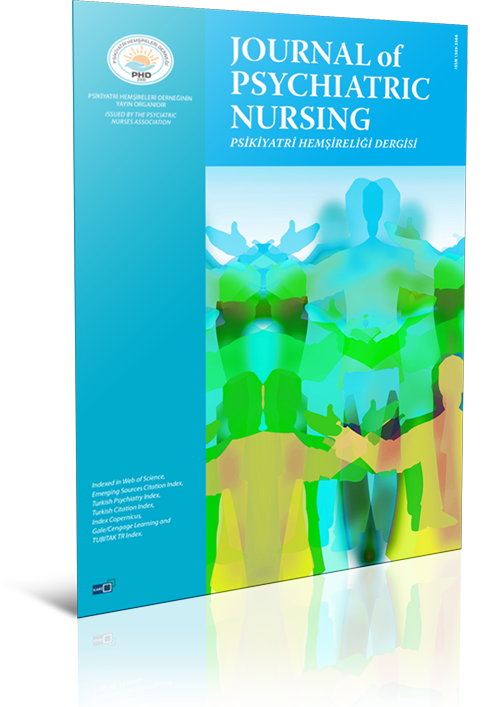
Volume: 15 Issue: 4 - 2024
| FRONTMATTER | |
| 1. | Front Matter Pages I - IV |
| 2. | Editorial Semra Karaca Page V |
| QUALITATIVE RESEARCH | |
| 3. | The need to achieve recovery for people with schizophrenia in the community: Service user and family perspectives Dewi Wulandari, Budi Anna Keliat, Herni Susanti, Besral Besral doi: 10.14744/phd.2024.66742 Pages 357 - 365 INTRODUCTION: This study aimed to describe the need to achieve recovery for People with Schizophrenia (PwS) in the community based on the perspective of service users and families. METHODS: This study was conducted through descriptive qualitative research. Three PwS groups and three family groups, with a total of 15 PwS and 16 families, were recruited through purposive sampling. Data collection was conducted through focus group discussions. The data analysis technique used was framework analysis. RESULTS: The study found two main themes: The perception of recovery and the need to achieve recovery. Perceptions of recovery include criteria for recovery, optimism in achieving recovery, and the benefits of recovery. The needs to achieve recovery include the psychological needs of PwS, family support, community support, and the support of health workers. DISCUSSION AND CONCLUSION: There were still PwS and their families who did not yet have the optimism to recover. It is necessary to develop interventions that take into account the perceptions and needs of PwS to achieve recovery. |
| 4. | Manager nurses views on the employment of consultation-liaison psychiatry nurses: A qualitative study Yasemin Çekiç, Tülay Demiray, Nazmiye Yıldırım doi: 10.14744/phd.2024.74419 Pages 366 - 375 INTRODUCTION: The aim of this study was to examine the views of manager nurses on the employment of consultation-liaison psychiatry nurses. METHODS: The study was conducted with an exploratory qualitative research design. The study group consisted of 20 nurses working in managerial positions. A total of five focus group interviews were conducted with three to five participants. Data were collected online using a semi-structured interview form between September 2023 and February 2024 and analyzed using thematic analysis. RESULTS: Four main themes and 10 sub-themes emerged from the analysis. The themes were decision-making (number of nurses, unit), dilemma (need, luxury), benefits (patients and patient relatives, staff and profession, managers and institution), and the road map (being visible, boundaries, empowerment). DISCUSSION AND CONCLUSION: According to the results of the study, nurse managers find the employment of consultation-liaison psychiatry nurses important, necessary, and useful. However, it is stated that priority cannot be given with the current number of nurses and it is suggested that this field should be introduced more, exemplary practices should be known, their contributions should be demonstrated with evidence, the need for trained manpower in this field and necessary legal regulations should be made. Psychiatric nurses have important duties in expanding the employment of consultation-liaison psychiatry nurses. |
| RESEARCH ARTICLE | |
| 5. | The relationship between quality of life and health literacy in individuals presenting to primary health-care institutions Meltem Çapar Çiftçi, Sevda Pınar Mehel Tutuk doi: 10.14744/phd.2024.28566 Pages 376 - 383 INTRODUCTION: This study aimed to determine the relationship between quality of life and health literacy in individuals presenting to primary health-care institutions. METHODS: The study was carried out with a descriptive cross-sectional design between March 5, 2022, and December 20, 2022. The study was completed with 800 individuals (n=800) who presented to Ağın Community Health Center. Descriptive statistics, independent-sample t-tests, analysis of variance, and correlation analyses were used to analyze the data. Data were collected using a descriptive characteristics form, the Turkish Health Literacy Scale, and the World Health Organization Quality of Life Instrument-Short Form. RESULTS: A significant and positive correlation between health literacy and quality of life was identified among individuals who presented to primary health-care institutions (p<0.05). Moreover, it was found that health literacy explained 46% of the variance in quality of life, indicating its strong impact. DISCUSSION AND CONCLUSION: In the study, it was determined that the health literacy of the participants was at a sufficient level, and their quality of life was moderate. It was observed that an increase in health literacy led to an improvement in quality of life. |
| 6. | Mental well-being and self-care practice of nursing students amidst the COVID-19 pandemic: A cross-sectional study with mixed methods approach Kesaraporn Choopun, Panida Palee, Amavasee Ampansirirat doi: 10.14744/phd.2024.61214 Pages 384 - 391 INTRODUCTION: COVID-19 has created widespread fear, distress, and despair, and has resulted in lockdowns and school closures in Thailand, affecting nursing education. The purpose of this study was to examine nursing students mental well-being and self-care practices throughout the pandemic and to identify the relationship between mental well-being and self-care practices. METHODS: A cross-sectional study involving 250 nursing students from a public nursing school in Thailand was conducted from July to August 2020. A set of questionnaires, including demographics, a Thai General Health Questionnaire, a Self-Care Practices Questionnaire, and focus group interviews were employed for data collection. RESULTS: The findings reported that 26% of nursing students had mental distress. Most students (73%) reported a good level of self-care by applying precaution techniques: distancing, mask-wearing, hand washing, temperature checking, and ThaiChana (D-M-H-T-T). In addition, the results revealed a significant, negative correlation between mental distress and self-care practices (r=−0.216, p<0.01). DISCUSSION AND CONCLUSION: These results emphasize the significance of self-care themes in boosting students mental health. Academic institutions must focus on mental health awareness campaigns and implement early intervention programs to successfully assist students in these challenging situations. |
| 7. | The effect of peer education on nursing students beliefs about mental illnesses Aydan Akkurt Yalçıntürk, Beyza Gül, Seyran Şevval Çimen doi: 10.14744/phd.2024.35545 Pages 392 - 398 INTRODUCTION: The aim of the study is to determine the effect of peer education on the beliefs of nursing department students about mental illnesses. METHODS: The research is a quasi-experimental study with pre-test-post-test control group. The sample of the study consisted of 72 1st-year students studying in the nursing department. Students were randomly assigned to the intervention and control groups according to their rank in the student list. While the peer education program was applied to the students in the intervention group, no education was applied to the students in the control group. The data were collected using the Personal Information Form and the Beliefs on Mental Illness Scale. RESULTS: It was determined that the mean scores of helplessness and deterioration in interpersonal relations, danger-ousness, and embarrassment of the students in the intervention group decreased significantly after peer education (p<0.05). In addition, after the peer education, it was determined that the students in the intervention group had significantly lower scores on the Beliefs on Mental Illness Scale and its sub-dimensions post-test scores than the students in the control group (p<0.05). DISCUSSION AND CONCLUSION: Beliefs developed by nurses about mental illnesses affect the quality of care provided to individuals with mental illness. Ignoring the negative beliefs of nursing students will lead to unexpected results for patient care in the future. As a result of the study, it was determined that peer education created a positive change in the beliefs of the nursing department students about mental illnesses. |
| 8. | Death anxiety and sleep quality in patients with implantable cardioverter defibrillators Mediha Sert, Zeynep Özer doi: 10.14744/phd.2024.94715 Pages 399 - 409 INTRODUCTION: Implantable cardioverter-defibrillators (ICDs) are an effective treatment for preventing sudden cardiac death, but they can cause certain psychosocial problems in patients. Although patients are particularly at risk for death anxiety and sleep disorders, these issues have not been addressed in any research together. The goal of this descriptive study was to investigate the link between patients with ICD and their levels of death anxiety and sleep quality. METHODS: Eighty-eight patients who fulfilled the inclusion criteria and attended a university hospital for routine battery follow-up participated in the study. The patient information questionnaire, the Pittsburgh sleep quality ındex, and the Templer death anxiety scale were used to collect the data. The data were analyzed with the SAS 9.4 package program. The Shapiro-Wilk test, t test, Chi-squared test, MannWhitney U-test, and variance analysis were used to analyze the data. RESULTS: Patients with low socioeconomic standing had poorer sleep quality (p<0.001), and women under the age of 50 had higher levels of death anxiety (p<0.001). In addition, ICD shocks substantially reduced sleep quality and raised anxiety levels (p<0.05). The anxiety and problems related to ICD increased death anxiety significantly (p<0.05). DISCUSSION AND CONCLUSION: In Turkish patients, ICD is linked to elevated levels of anxiety about death and poor sleep quality. The studys findings are expected to will donate to the biopsychosocial support of the patients by planning appropriate interventions to improve the sleep quality and anxiety levels of the patients. It is advised that the findings of the study be examined with subsequent studies and various populations to differentiate the effects of comorbid conditions and cultural traits on ICD experiences. |
| 9. | Effects of web-based education on HbA1c, quality of life and depression levels in adolescents with type 1 diabetes Sema İçel, Birgül Özkan doi: 10.14744/phd.2024.05882 Pages 410 - 419 INTRODUCTION: Type 1 diabetes mellitus (T1DM) can create physical, psychological, and social problems, obliging the individual to adopt considerable changes in lifestyle. This study was conducted to determine the effect of diabetes education by using the web-based Watsons human care model on HbA1c, levels of depression, and quality of life of T1DM adolescents. METHODS: This study was conducted between January and December 2017. The research had an experimental design with pre- and post-test control groups. The participants were randomly assigned to the experimental and control groups. The study was conducted with 30 adolescents between 11 and 18 years old. Adolescents in the experimental group were trained using the web-based Watsons human care model, live video interviews were made in 14 sessions and these interviews were recorded. RESULTS: It was observed that there was a significant decrease in levels of depression for adolescents of the experiment group before and after web-based education (p=0.000); a significant increase in quality of life (p=0.000) and a positive significant change in the levels of HbA1c (p=0.001). DISCUSSION AND CONCLUSION: It is recommended that developed and extended Diabetes Education prepared based on web-based Watsons human care theory. |
| 10. | The relationship between mental health literacy and psychological help-seeking attitudes of nursing undergraduate students: A cross-sectional descriptive study Serap Açıkgöz, İlknur Göl doi: 10.14744/phd.2024.27003 Pages 420 - 426 INTRODUCTION: To determine the relationship between mental health literacy (MHL) levels and psychological help-seeking attitudes levels among nursing students. METHODS: This cross-sectional and descriptive study was conducted with 306 nursing students. Data were collected using a Personal Information Form, the MHL Scale, and the Attitudes Toward Seeking Professional Psychological Help Scale-Short Form (ATSPPHS-SF). Data were collected online through Google Forms. In the study, descriptive statistics, Pearson correlation analysis, and linear regression analysis were used. RESULTS: Mean total scores on the MHL Scale and ATSPPHS-SF were 12.44±3.22 and 9.29±2.69, respectively. There was a positive and significant correlation between the score of resource-oriented MHL and ATSPPHS-SF (r=0.180, p<0.05). The resource-oriented MHL explained 3.2% (R2=0.032) of the increase in attitudes toward seeking professional psychological help and increased attitude toward seeking professional psychological help by 40% (β=0.400) (p<0.05). DISCUSSION AND CONCLUSION: The MHL and attitudes toward seeking psychological help of nursing students participating in the study were at a low level. As the resource-oriented MHL of the nursing student increased, their attitudes toward seeking psychological help levels increased, as well. For this reason, it can be recommended to give importance to training on preventive mental health services in the pre-graduate period to increase MHL levels and develop a positive psychological help-seeking attitude. |
| QUALITATIVE RESEARCH | |
| 11. | The efficacy of the triple P: Positive parenting program for parents of teenagers in Iran Leila Norouzi Panahi, Maryam Modarres, Seyedeh Tahereh Mirmolaei doi: 10.14744/phd.2024.54715 Pages 427 - 437 INTRODUCTION: Adolescence is a stage of life with fast cognitive, biological, and neurological changes. It has been shown that behavioral problems increase in late childhood and early adolescence. When mental, emotional, and behavioral health disorders are not effectively treated, the impact on the individual, their families, and society more broadly can be devastating and long-lasting. The aim of this study is to determine the effectiveness of Standard Teen Triple P (STTP) with parents who have behaviorally disturbed adolescents. METHODS: The research was conducted using quasi-experimental research on 78 parents who had teenagers aged between 11 and 16 years experiencing detectable behavioral and emotional problems. The participants were allocated to two groups, that is, 39 participants to the intervention group, and 39 to the control group. The data were collected using a demographic questionnaire, the strengths and difficulties questionnaire, conflict behavior questionnaire, and general health questionnaire-28. The STTP was carried out for the intervention group for 10 weeks. The data were collected immediately after the intervention, and also 2 months after the intervention. The data were evaluated using t-test, χ2 test, variance analysis, multivariate analysis of covariance, and analysis of covariance test. RESULTS: It was found that participation in the STTP resulted in improvement in parents mental health, reduction in adolescent problem behaviors, and fewer parent-adolescent conflicts. DISCUSSION AND CONCLUSION: STTP must be made available to parents of teenagers in Iran. |
| RESEARCH ARTICLE | |
| 12. | The level of sexual embarrassment and the affecting factors in married women applying to the obstetrics and gynecology outpatient clinic, and the effect of sexual embarrassment on sexual self-confidence, sexual satisfaction, and dyadic adjustment Ayşegül Kılıçlı, Simge Zeyneloğlu doi: 10.14744/phd.2024.59376 Pages 438 - 449 INTRODUCTION: It was aimed to investigate the level of sexual embarrassment and the affecting factors in married women applying to the obstetrics and gynecology outpatient clinic, and the effect of sexual embarrassment on sexual self-confidence, sexual satisfaction, and dyadic adjustment. METHODS: This descriptive cross-sectional study was conducted between August 9 and October 17, 2022, with 528 married women. Descriptive Information Form, Sexual Self-Consciousness Scale embarrassment subscale, Sexual Self-Confidence Scale, New Sexual Satisfaction Scale, and Revised Dyadic Adjustment Scale were used to collect data. RESULTS: It was determined that the mean score of sexual embarrassment was moderate. It was found that the place of residence for the longest period of time being a town/village, not having social security, and not working positively predicted the mean sexual embarrassment score of women, while the age of the spouse predicted it negatively (p<0.01). It was found that the mean score of sexual embarrassment negatively effected the mean score of sexual self-confidence, sexual courage, sexual awareness, sexual self-disclosure, self and partner-centered sexual satisfaction, dyadic adjust-ment, dyadic satisfaction, and dyadic consensus (p<0.01). DISCUSSION AND CONCLUSION: It is suggested that women who apply to obstetrics and gynecology outpatient clinics to receive health care services may frequently experience sexual shyness, sexual shyness in these women may negatively affect womens sexual life and couple harmony, therefore, sexual health education programs and effective sexual health counseling services should be provided to women by nurses together with their partners to maintain their sexual life, which is private and intimate for women, in a healthy way. |
| 13. | Psycho-educational program to enhance expressed emotion and reduce burden of care among family caregivers of patients with polysubstance abuse Shimaa Saied Adam Mohamed, Amal Gamal Elsayed Awad, Hanaa Sayed Ewise, Samah Abdulwahed Ahmed Ali doi: 10.14744/phd.2024.09086 Pages 450 - 457 INTRODUCTION: Polysubstance abuse can result in significant adverse effects on an individuals physical, mental, and social health, affecting families and leading to increased stress, anxiety, depression, and financial difficulties. This study evaluated the effect of a psychoeducational program to enhance expressed emotion (EE) and reduce the burden of care among family caregivers of patients with polysubstance abuse. METHODS: The study was conducted at the addiction clinic in the El Abasia Psychiatric and Mental Health Hospital, in Egypt using a quasi-experimental design that involved a pre-test and a post-test. The study involved 62 caregivers of polysubstance abuse patients, and data were collected in the period from June to December 2022. The data were collected by online survey which includes socio-demographic data assessment questionnaire, caregivers knowledge about polysubstance abuse form, patterns of EE scale, and Zarit Burden Interview scale. RESULTS: The ages of 72.60% of family caregivers ranged from 30 to 40 years. The total knowledge score was 54.6% pre-program implementation versus 87.2% post-program. Furthermore, 70.7% of caregivers had high EE pre-program versus 26.4% post-program. In addition, 78.4% of caregivers reported high burden pre-program implementation versus 32.8% post-pro-gram. The scores related to caregivers EEs and burden following the implementation of a psycho-educational program were significantly improved, (p<0.001). The total EE and total burden scores of caregivers were more significantly positively correlated pre-program than post-program implementation (p<0.001). DISCUSSION AND CONCLUSION: Implementing the psycho-educational intervention had resulted in a positive statistically significant impact on improving the EE of family caregivers and decreasing the burden of patient care. |
| 14. | Effect of psychological first aid training given to nursing students on psychological resilience and self-efficacy Nurhayat Kılıç Bayageldi doi: 10.14744/phd.2024.49260 Pages 458 - 465 INTRODUCTION: This study aimed to determine the effects of psychological first aid (PFA) training on the resilience and self-efficacy of nursing students. METHODS: This single-group, semi-experimental study was performed on 68 nursing students who did not receive PFA training and service earlier, had Internet access, and agreed to participate in the study by giving informed consent. The study involved pre-test/post-test and follow-up measurements. The data were collected electronically by creating an online survey platform and using a personal information form, the Psychological Hardiness Scale, and the General Self-Efficacy Scale. The PFA training, which lasted 60 min, was carried out with the students twice a week for 3 weeks. The data were statistically analyzed using descriptive statistical methods (mean, standard deviation, and frequency), t-test, one-way analysis of variance (ANOVA) (F test), and ANOVA in repeated measurements. The relationship between the Psychological Hardiness Scale and the General Self-Efficacy Scale was examined by regression analysis. RESULTS: The average age of the individuals who participated in the study was 22.71±1.87 years. The post-training (62.16±7.71) and follow-up (63.10±5.70) Psychological Hardiness Scale mean scores of the individuals were significantly higher than the pre-training mean scores (49.64±6.32) (p<0.001). The post-training (30.34±4.43) and follow-up (29.41±4.06). The General Self-Efficacy Scale mean scores of the individuals were significantly higher than the pre-training (24.64±3.51) mean scores (p<0.001). The regression analysis revealed that 45% of the change in the psychological resilience of individuals was explained by self-efficacy (R2=0.453). DISCUSSION AND CONCLUSION: The PFA training increased the psychological resilience and self-efficacy perceptions of the participants. Hence, systematic training should be provided to individuals, including the principles of applying PFA. |
| LETTER TO THE EDITOR | |
| 15. | The role of artificial intelligence (ChatGPT) in psychiatric nursing Mustafa Durmuş, Ayşe Okanlı doi: 10.14744/phd.2024.75317 Pages 466 - 467 Abstract | |
| OTHER | |
| 16. | Reviewer List Page 468 Abstract | |


















